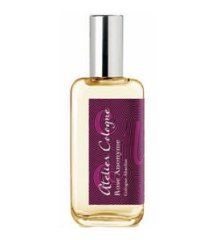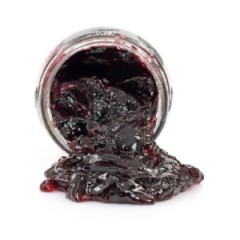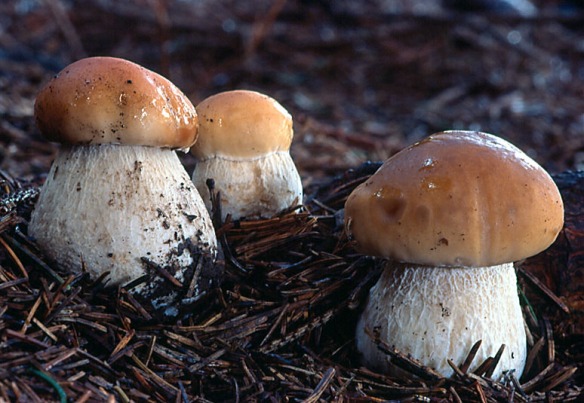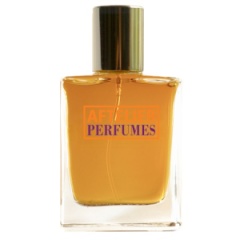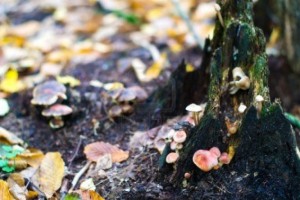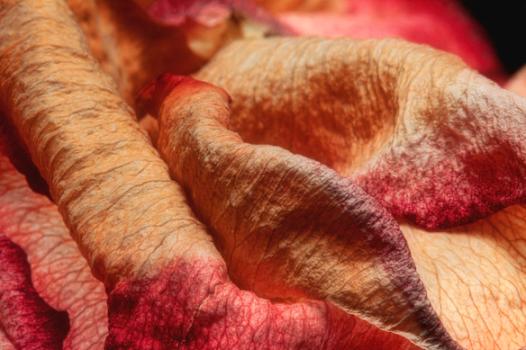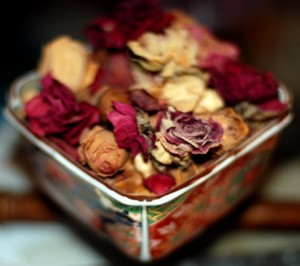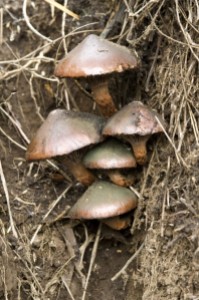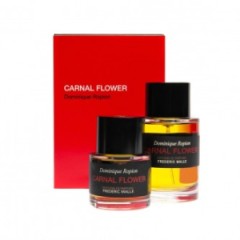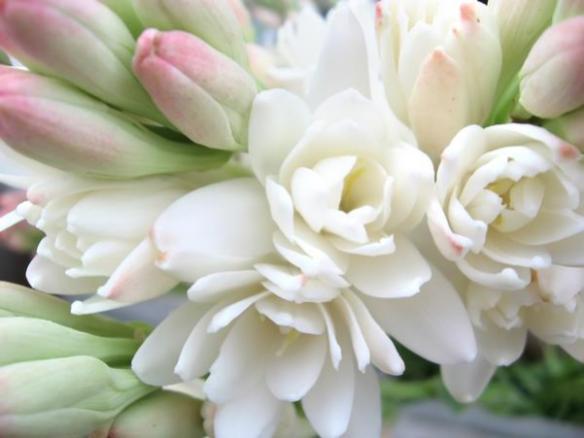On occasion, I’ll come across a perfume whose most striking characteristic for me is a textural one. Instead of specific notes or a movement of change throughout the stages, the perfume merely evokes a lovely creaminess that is almost devoid of an actual olfactory smell. That is the case for me with Orris Noir, a fragrance from Ormonde Jayne that is meant to be so “haunting” that it “defies description.” I’m afraid it fell far short of such a description in my eyes, but, then, in all fairness, what fragrance could positively live up to that line?
Ormonde Jayne is a high-end, niche London perfume house founded by Linda Pilkington in 2002. All her perfumes are created in conjunction with Geza Schoen, and Orris Noir is no exception. The fragrance was released in 2006, and is available in two concentrations: pure parfum (with 30% fragrance oils) and eau de parfum (25%). This review is for the eau de parfum.
Ormonde Jayne’s website describes Orris Noir as follows:
Orris Noir – so haunting, it almost defies description.
The Iris flower is named after the Greek Goddess of the rainbow, the messenger of the Gods and the Black Iris of Amman is the Royal symbol of the Kings of Jordan. Thriving in a landscape of ample sun, it is a rich, purple black flower of smouldering beauty.
This dark, spicy Oriental scent is for those who want to leave their mark.
A spellbinding perfume, Orris Noir is a rich, seductive aria of unmistakable individuality, not for shrinking violets.
Top Notes: Davana, pink pepper, coriander seed, bergamot
Heart Notes: Iris, [jasmine] sambac absolute, pimento berries, bay
Base Notes: Incense, myrrh, patchouli, chinese cedar, gaiac.
Orris Noir opens on my skin with black peppered lemon and cream, followed by a touch of pink peppercorn berries and a whisper of fruit. A spectral hint of rooty iris pops up at the edges, but it is very subtle. It carries the tiniest undertone of sweet carrots, I think, but the iris note as a whole is so muffled that it may well be my imagination. Certainly, when I’ve tested Orris Noir in the past using only a small quantity, none of it showed up. Instead, the main bouquet smells to me of a very milky, creamy tea with lemon, a vague and nebulous floralacy, pink peppercorns, and a touch of something fruity.
The issue of quantity impacting notes is interesting when it comes to Orris Noir because I noted differences based on that amount of scent that I apply. When I applied only a small quantity (perhaps 1/3 of a 1 ml vial), there was a brief suggestion of something fiery or biting from the pimento chili peppers, but it was so fleeting that it too may have just been imagined. At the same time, there was a more distinct puff of black incense in the background, but you had to sniff extremely hard and long to really detect it. Both elements, however, were minor and barely lasted.
In contrast, I could definitely detect the iris when I applied a greater amount of Orris Noir. (I used about 2/3rds of a 1 ml vial.) Regardless of quantity, however, and taken as a whole, the iris feels like a tertiary, very quiet, very muted player on the sidelines. For a fragrance that is intended to be a dark homage to iris, I’m afraid that Orris Noir was really everything but that for the majority of its development on my skin.
Instead, the primary bouquet of Orris Noir in its opening hour on my skin is extremely creamy Earl Grey tea. Not milky, for the textural quality of the fragrance goes beyond a merely lactonic quality, but rich, smooth cream. It’s infused with lemon, pepper, and, after 20 minutes, by the Davana. I happen to really like the last note, and I think Davana is an element that should be used more often in perfumery. It is an Indian flower with a very lush, velvety, floral smell and a fruity undertone, most specifically of apricots. Here, with Orris Noir, the apricot tonality is extremely subtle at first and the main aroma is of a petal-soft, vaguely tropical flower with endless creaminess.
Orris Noir remains that way for the next few hours, largely unchanged except for the sillage and subtle variations in the notes. It’s all lemon-pepper cream with davana florals, and an increasingly strong sense of fruitiness. The iris lingers like a ghost in the back, as does the cedar. In fact, the two together generally impart a wholly abstract, nebulous undertone of a woody, floral musk, but neither note stands out on my skin with any individual character. I would never sniff Orris Noir and think, “Ah, Iris,” because the flower is practically a nonentity on me after the first hour.
At the start of the second hour, the sillage drops to an inch or two above the skin, though the perfume is easily detectable if sniffed up close. The only major change occurs about 2.5 hours in, when there is the first, very muffled suggestion of jasmine. Orris Noir’s main characteristic continues to be a very smooth, textural creaminess, though it is becoming increasingly difficult to pull it apart into a specific, actual olfactory note. It also now feels more nebulously woody than purely floral in nature.
About 3.5 hours in, Orris Noir is a creamy, lemony, floral skin scent with light touches of jasmine, soft abstract woodiness, and a slightly fruited nuance. It remains that way until the end of the 6th hour when the jasmine finally steps out of the shadows, and takes over. There are lingering traces of the davana, but Orris Noir is primarily a very sheer, blurry wisp of sweet jasmine woody musk. The perfume remains that way until its very end. It lasted 8.75 hours with a large quantity, and just over 7.75 hours with a smaller amount.
Orris Noir is very pretty, easy-going, approachable, and smooth, but it is also a bit underwhelming, if I’m to be honest. Its creaminess was its most distinctive feature for me, and something that I enjoyed a lot. Plus, to my relief, Orris Noir had only the most microscopic drop of ISO E Super, unlike some Ormonde Jayne fragrances which practically ooze it out of every pore. Orris Noir was well-balanced, had some pretty bits, and was perfectly pleasant as a whole. Yet, I really wasn’t moved; none of it sings or stands out for me.
Tania Sanchez seems to have had much greater problems with Orris Noir. In Perfumes: The A-Z Guide, she classifies Orris Noir as a “peppery cedar” and gives it a low 2 stars. Her reviews states:
The name combines two of the biggest recent trends: orris (iris-root butter) is showing up everywhere, and so are perfumes named Something Noir (or Black Thingamajig). The trouble is that there’s nothing particularly iris or noir about this. Instead, it smells like lemon and pepper with an oily-woody background, slightly chemical and faceless, a rare misstep for the excellent Ormonde Jayne line.
I really don’t think it’s that bad, not by any means, though I do agree with the “faceless” part. I think my feelings would be different if I experienced a lot (or even some) incense in the fragrance, but I did not. Like Tania Sanchez, I thought Orris Noir was lemony-pepper, albeit with davana creaminess, some jasmine, and a nebulous woody musk.
Other bloggers, however, definitely experienced more incense, spiciness, and darkness than I did. Whether you read Eyeliner on a Cat, Bois de Jasmin, or The Non-Blonde, they seem to have detected a more sultry, quasi-oriental fragrance, though no-one thinks that the iris dominates or that Orris Noir is particularly bold. The bloggers all liked Orris Noir, and Bois de Jasmin’s review is quite representative of the general consensus:
Even if Ormonde Jayne Orris Noir does not present its promised black iris, it more than makes up for it with its exquisite combination of spices, incense ashes and velvety woods. Its form crafted out of resinous and balsamic notes is nevertheless rendered as luminous and weightless, like silk, rather than wool.
The spicy notes provide an opulent leitmotif that persists as Orris Noir develops. They frame the lemony green top notes and foil the sheer floral heart. The echoes of sweet warmth of allspice can be noticed in the rich woody base. The chilly breath of iris is quite a subtle accent in this vivid arrangement, yet it lends a certain restraint. Incense, smooth and smoky, envelops the composition in its translucent dark veil.
My skin seems to have brought out more of the davana creaminess than anyone else, especially as compared to those on Basenotes. They generally like Orris Noir, though not everyone gushes enthusiasm. Take the review by “Alfarom” who writes, in part:
No iris whatsoever, not “noir” at all.
That being said, if you’re fine with a peppery-woody-incensey fragrance dominated by a nice, yet unquestionably synthetic vibe, this is a pretty decent composition. Kinda dry yet, somewhat, slightly powdery, woody and incensey with nice piquant undertones. Far from being a masterpiece yet nice.
A number of women absolutely adore the scent, though a few think they detect a “rose” note which I suspect might be the davana at play. One of the more positive reviews reads:
Three words to describe Orris Noir: Gorgeous, gorgeous, gorgeous. Lighter than its name implies, but spellbinding nonetheless, ON skims along the surface of the skin so deftly I kept expecting it would disappear entirely any minute. Instead it became creamier as it opened up, and was still marvelously “there” hours after I first put it on. It is a beautiful blend of light spices and delicate exotic florals, the pink pepper, coriander and powdery iris (fortunately more iris than powder) definitely come through on me.
On Fragrantica, there is the same generally positive response to Orris Noir. Interestingly, a greater number of commentators picked up on the creaminess and the “candied, fruity” elements in the scent, while one reviewer, “Cohibadad,” also detected plenty of iris. Generally, a number of people seemed to think Orris Noir was quite oriental in feel, which just goes to show you the importance of one’s personal and definitional standards. For me, Orris Noir isn’t remotely oriental, even if one doesn’t use brands like Amouage as a baseline. For me, it’s a floral woody musk. I think that it is all going to depend on your skin chemistry and on your personal standards.
Orris Noir isn’t my personal cup of tea, but it’s a nice fragrance and those who like airy, creamy, discreet florals may want to give it a try. I think it skews somewhat feminine, as do some men on Basenotes, but it all depends on what you’re comfortable with. It is a very approachable scent that is versatile, and could also be worn to the office without making waves.
Disclosure: I was sent Orris Noir for review by Ormonde Jayne, but I had previously purchased my own sample from Surrender to Chance, and that is what I used for this review. In all cases, I do not do paid reviews, my opinions are my own, and my first obligation is honesty to my readers.








